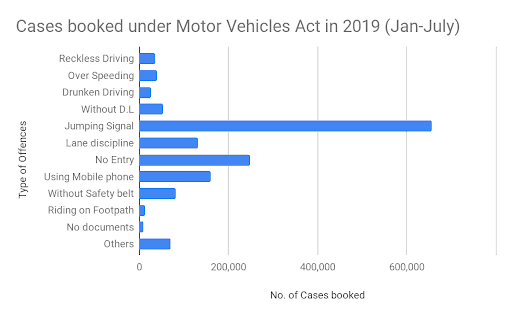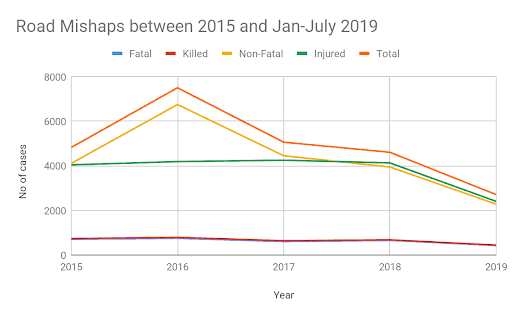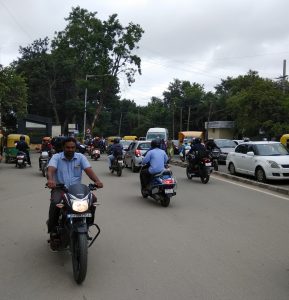Melissa Arulappan recently counted 13 bikers driving on the wrong side on a one-way street, all within two seconds. This is not a one-off incident. Citizens across Bengaluru have been noticing an increasing number of such violations in the recent past. What’s going on?
In 2019, just till July, the Bengaluru Traffic Police booked over 1.3 lakh cases for not following lane discipline, 2.4 lakh cases for violating ‘no entry’, and 36,579 for reckless driving. In the same period, there were 2713 road accidents in the city that killed 445 people in all.
Given over 13,600 kilometres of main roads in the city, and total traffic police strength of just 5000, it looks like there could be more violations than bookings.
Traffic violations booked under ‘lane discipline’ offence:
- 2017: 458,167
- 2018: 387,668
- 2019: 132,767 (till July)

In 2018, 684 people were killed in road accidents in the city. There were 4611 accidents that year, overall.

It is evident from the chart above that number of fatal accidents has not reduced in the last five years. Neither the shocking data nor the efforts by the authorities to control such fatal incidents have made any difference, as people continue to break rules.
Lawlessness or helplessness?
Melissa Arulappan, a public relations professional and resident of Richards Town, was appalled by what she noticed near the Mosque Road Bridge in Frazer Town recently. She saw 13 bikers driving on the wrong side on a one-way street, all within two seconds. Worse, the bikers were riding without helmets, and some had children in the pillion.
Melissa’s complaint to the local traffic police did not help. They pleaded helplessness, saying even if they booked the violators, no action would be taken against them at the police station because of pressure from political lobbies.
“So, the traffic cops stand on the side from where the bikers are not supposed to enter, and deter them from entering the wrong side of the road. They are there for a few hours, after which it is back to square one,” she says.
One city, one story
At the other end of the city, 38-year-old Abhay Porwal, a patent attorney and resident of Whitefield, has been fighting a battle against those who break lane rules, for a long time.
He has been posting videos and pictures on Twitter and other social media platforms, highlighting the issue of wrong-side driving for the past year-and-half. He says that IT professionals working in the neighbourhood are regular offenders and that they put school buses in danger.
Abhay recounts an incident wherein he stopped a man who was riding in the wrong direction on Brookfields Road. Abhay says, “He asked me to come out of my car, and when I did, he and his pillion rider started beating me. They asked me to go check the CCTV camera and figure out who was wrong.”
Abhay says the police are more focused on traffic management than enforcing rules. “If there are hundreds of people coming in the wrong direction, the traffic police will ask them to wait and give them way when the traffic opens up. How do we find a solution to this?” he asks.
What the cops say
| “Traffic Police is already short of staff, and most days, almost half the police personnel will be on duty at Vidhan Soudha.” |
When asked about the increasing cases of drivers breaking lane discipline in the city, specifically near the 16th Main traffic signal (next to Advaita petrol station), popularly known as the Udupi garden signal, Mico Layout Traffic Police Inspector Puttamaddiah says such cases have increased over the past few months. “The Jayadeva flyover is being demolished in phases. Due to this, there are a few who take the easy way out by riding on the wrong side during peak hours.”
Puttamaddiah says the traffic police have been taking measures to reduce this, but the department is already short of staff, and most days, almost half the police personnel will be on duty at Vidhan Soudha. “With the limited resources we have, we are doing the best we can,” he says.

A biker without helmet rides on the wrong side of the road near Udupi Garden junction. Pic: Kedar Koushik
Anil Kumar P Grampurohit, Police Inspector (Traffic and Planning) at the Traffic Management Centre (TMC) in Ashok Nagar, agrees that wrong side driving has increased in the city despite efforts by the authorities to contain them. TMC is the hub of the city’s transport management system, where real-time data is used to control traffic.
“We are taking measures like surprise-checking and deploying officers at junctions from where we have got complaints. But we lack the manpower to deploy police personnel at such junctions throughout the day. We are looking into the issue,” he says.
Root cause and solutions
But why do people break the rules in the first place? Is there a solution to this menace? Will imposing hefty fines solve the problem?
Anusha Jaishankar, who runs a road safety behaviour change initiative called Positive Strokes, says the problem lies in the way the roads are planned and the city has developed. “Our roads are clogged. Sometimes we are unable to take the ideal turn, and have to go a few kilometers further through dense traffic to get to the place we want to go to. In a situation like this, people will prefer going in the wrong direction for a few meters.”
She says that rules should be made easy to follow. “The roads should have more options for turning, and people should be allowed to turn when there is a clogged corridor.” She advocates a multi-pronged approach based on design, planning, education and then enforcement. “Doing street audits and making use of traffic furniture to ensure smooth flow is where we should begin… Increasing awareness within small communities and asking citizens to help out with traffic management can also bring change,” Anusha says.
But for S Satyapal of the National Road Safety Organisation, an NGO that helps build road safety awareness, people break rules because there is no fear of law. “The enforcement of law should be very strict, and penalties must be high not only in the main roads but also in the inner roads. Enforcement cameras and other technology should be made use of, and people should fear the law whenever they come out of their gates.”
Anusha feels otherwise, “I am absolutely not in favour of having new laws that we cannot impose and enforce, and then letting people break these as there is no one to check violations. Hefty fine will hurt people, yes, but you need enforcement for it.”
Melissa’s public complaints too had no effect. The Deputy Commissioner of Police – Traffic (East) replied to her tweet last week, tagging Frazer Town and Shivajinagar police stations and the Assistant Commissioner of Police – Traffic (East). And that was it.
Without fixing the fundamental issues of road design, people’s behaviour and enforcement bandwidth, things are unlikely to improve anytime soon.


Implementation of traffic safety rule has been utter failure in Bangalore .It has become a passion amongst youngsters to drive on the wrong side of road that too without helmet,triple,quadruple riding. In such case ,my opinion is, vehicles must not only be ceased but also such riders should be blacklisted lifetime for such acts.
Public Eye posting is only penalising the offenders. I have posted many such photos of multiple violations with no proper action.
I see them repeating
Blaming infrastructure, or lack of it, to justify not following traffic rules is not the way to go. In almost all cases, the time saved by breaking a traffic rule is negligible. Prohibitive fines are the only way to go, like in Singapore. The new MV bill will go a long way to fix the problem.
The problem can be solved if cops are mobile and not static. Instead of stationing themselves at select points, which offenders are aware of, they must keep on patrolling on their motor cycles with mounted cameras. When people know that they can be caught, the number may reduce. My complaints on facebook or twitter has not been considered.
Rule or no rule , traffic or no traffic – I’ll go where I want to on my own terms – this seems to be the attitude of most people riding on the wrong side of the road!
Respect for others rights and awareness of safety of self and others and awakening their civic sense is of prime importance to solve this- mere enforcement and fines won’t do the job! Drastic measures like suspending license for one month and so on should be done to make these morons understand!!
To contain traffic violations the mobile squad to catch the offenders and penalize them
Squad in mufti to control the offenders
By observing in one particular spot many jump or avoid the route
How about riding on the pavements? So called educated, smarts are seen riding on the pavements when the traffic comes to a halt. I’ve been saying this for a while to the traffic police – “Install spikes that will tear the tyres, from end to end across the road, in the appropriate opposite direction and you won’t have to stand there to manage the traffic. Warning boards at these spots will take care of alerting the people. Inherent discipline, when found lacking, can be enforced easily by the installation of some devices. This, coupled with a WILL to resolve the traffic situation, should see better traffic flow. A multi pronged approach is needed for any urban city, today. Improving the public transport system by leaps and bounds has known to help. Making traffic lights change frequently, at intersections, whereby the wait for most people will be really short and the roads ahead will also be able to handle smaller number of vehicles at a time, at any given point – have all proven really helpful in many countries. Then, enforcement and stiffer penalties can be an addition to better regulation.
I agree with the well analysed article written by the author. Punishments are not the panecia for the problem. Truck traffic should be banned during the day time on main roads within the city. Declaring one ways without alternate roads to reroute is vehicle traffic inside the City should be avoided. Let us be pragmatic in tree planting in the roads. Most of our roads inside the City are just enough for one vehicle. If we plant trees even this space will be eaten away by Trees. Allowing multy storied Building in existing sites allotted by CITB/BDA for a single storied building within the City should be strictly avoided.
Above all “lane traffic” should be strictly followed by all vehicles.
Bad road infrastructure has nothing to do with our “I dont care” attitude. Bike riders in Taiwan are disciplined and do not zig-zag or ride in the wrong lane. We are programmed to not follow simple civic or traffic rules. The traffic police, can, instead, of catching helmetless riders, can focus on this wrong side driving menace which is a dangerous and probably fatal too.
It would be great if we are able to solve the city’s road traffic congestion in a phased manner
I have been thinking and working on this for a while now and have been studying on the solution adopted by various countries,
One solution that fits Bangalore traffic is lane discipline.
As more than 50% of the road is occupied by 2 wheelers,it would be appropriate if 10% of roads on both sides of the one way are dedicated to “2 wheelers only”,so that the 2 wheeler congestion is removed,if this option looks not that feasible, then may be 25-30% of one side of the road can be dedicated to 2 wheelers,,,,
I M sure if 2 wheeler traffic managed ,,,80%of our daily commute can be resolved.
I see no harming in trying this on a pilot basis in some selected high 2 wheeler traffic areas of Bangalore,,
Regards
Sundeep